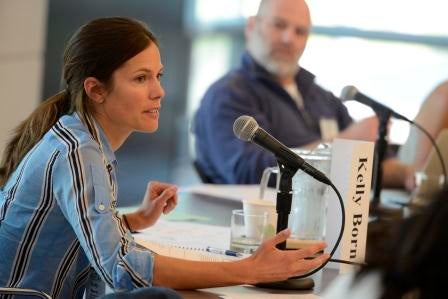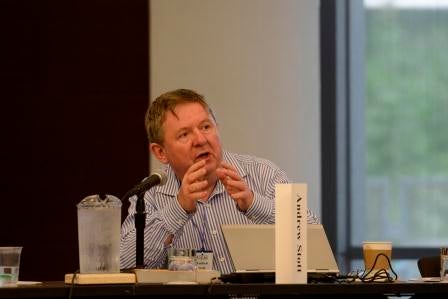Panthea Lee is a principal at Reboot, a social enterprise working to improve governance and development worldwide.
The Aspen Institute Communications and Society program series on open government will appear on the Aspen Institute blog over six weeks. This is the third post in a six-part series on open government. By sharing the conversations at the 2013 Forum on Communications and Society (FOCAS) and the ideas they inspired, we hope to advance a constructive dialogue around open government and a future of more equitable and accountable governance.
The central irony of open government is that it’s often not “open” at all. For all the talk of technology’s broad and inclusive reach, conversations on open government are dominated by those with the means to participate. In one Italian parliamentary monitoring project, participants were mostly men (84 percent) and 3,500 times more likely to hold a PhD than the average citizen. The priorities raised, as a result, represent the views of a narrow and elite group of citizens.
At FOCAS 2013, Kelly Born of the Hewlett Foundation (pictured right)  asked attendees, which included senior executives from the Sunlight Foundation, the White House, and the Open Data Institute, “Is this [group of FOCAS participants] the right group of people to set goals for open government? Where are the citizens in this process?”
asked attendees, which included senior executives from the Sunlight Foundation, the White House, and the Open Data Institute, “Is this [group of FOCAS participants] the right group of people to set goals for open government? Where are the citizens in this process?”
The practical result of those with power, privilege, and access tinkering for solutions while large citizen segments remain uninvolved is that open government initiatives are clouded by our own biases and tunnel vision.
We seek open government of the people, by the people, for the people — not open government by some people for some other people. To ensure open government does not become a hollow buzzword and lives up to the promise of its name, we need to recognize and address our biases.
The Issue: Biases Lead to Short-sighted Solutions
With technology as such an obvious and visible driver of open government, the space is dominated by technologists with novel and creative ways to use their skills in the service of the public good. Gaps in their logic are given short shrift, as catapulting towards innovation is far more exciting than deliberating about unintended consequences. Hype-mongers and innovation-hawkers don’t help. And so government officials and civil society groups have been seduced by technology, by its novelty, and its capacity to relieve them from the hard work they have typically done towards social change.
 While technologists’ passion has energized open government efforts and given them purpose, it also left them willfully blind to alternative viewpoints. Do citizens and governments actually want this stuff?
While technologists’ passion has energized open government efforts and given them purpose, it also left them willfully blind to alternative viewpoints. Do citizens and governments actually want this stuff?
“There seems to be an underlying premise [among the open government community] that government is open to being open,” said Mark Meckler (pictured left) of Citizens for Self-Governance at FOCAS. “But many governments are reluctant. We need to recognize this.”
Instead, technologists have often equated embrace of technology with embrace of open government.
Take Kenya, oft-celebrated as an open government success. Two years ago, the government launched the Kenya Open Data Initiative. At the launch, President Mwai Kibaki said, “I also call upon Kenyans to make use of this Government Data Portal to enhance accountability and improve governance in our country. Indeed, data is the foundation of improving governance and accountability. … This way the people can hold government service providers accountable for the use of public resources.”
The Initiative has neat apps, a Twitter account, a Facebook page, and has enabled the Code for Kenya program. In 2012, Kenya joined the Open Government Partnership.
In that same year, however, at least 28 journalists were threatened or attacked by government bodies for their coverage of state corruption. And today, the country is considering legislation that would further tighten media regulation — already described by local journalists as “emasculating.”
A technocentric view means that as long as a government embraces new technologies, releases some datasets, and makes high-profile commitments to the international community, it is a card-carrying member of the open government community. Whether the government actually allows its citizens to freely and openly use open data is apparently irrelevant.
The Solution: Refocus Our Thinking on Incremental Innovation
So what does it mean that 62 countries have joined the Open Government Partnership? On its own, not much. To move beyond our biases, we need to stop chasing white whales and refocus our thinking toward a more humble target.
“New techniques, not just new technologies, are important in advancing open government innovation” noted Andrew Stott (pictured right)  of the UK Transparency Board. He should know. Stott led the work to open up UK government data and create Data.gov.uk. And in his experience, the means are just as important as the ends.
of the UK Transparency Board. He should know. Stott led the work to open up UK government data and create Data.gov.uk. And in his experience, the means are just as important as the ends.
Innovation is, very simply, “a new method, idea or product.” Approaches to innovation should differ based on when, where, and how that innovation is expected to have an impact. Leading CEOs advise against blindly pursuing breakthrough innovation — in many contexts, incremental innovation is the better option.
According to Karl Ulrich, Wharton’s innovation guru: “A lot of companies suffer from intense organizational angst that they are not pursuing radical innovations, the seeds of future growth. This angst is largely misplaced. Most investment in innovation can and should be made in incremental innovation — delivering solutions to customers that are better, faster, and cheaper.”
In the context of risk-averse governments, slow-and-steady innovation indeed seems like a better option.
Incremental innovation demands a more grounded look at a system as it currently exists and an understanding of where concrete wins can occur within that system. In a nutshell: let’s stop trying to build the open government house of the future and refocus our efforts toward fixing the plumbing in the house that we have.
As Michael Maness of the Knight Foundation reminded FOCAS participants, “A lot of the most important opportunities in open government are detailed or mundane. How can we focus on energies towards seizing those opportunities?”
Ideas in Practice: OpenGov4Us and GitMachines
The winners of the recent Knight News Challenge on Open Gov are indicative of the kind of innovations we need: Those that look beyond technology and those that focus on the “plumbing” of open government. Open Gov for the Rest of Us is an engagement campaign that helps enable Chicago’s low-income communities to take advantage of open government tools, by providing training on computer skills and data literacy.
At FOCAS, Taryn Roch of OpenGov4Us explained her team’s motivation to found the program: “We were frustrated by the open government’s movement on technologists, and asked ‘Can citizens be at the center of this?’ OpenGov4Us is about citizen engagement. Technology was just a starting point.”
The campaign hopes that its work will allow diverse and often under-represented communities to help shape Chicago’s open government priorities. Its users, for example, have surfaced unmet data needs that are relevant to them — datasets on immigration and foreclosure. And as most of OpenGov4Us participants are Latino or African-American, who rely on mobile internet more than white Americans — they also seek tools that are mobile-friendly.
On the government side, GitMachines is building infrastructure to enable open government. A lot of open government software is under-adopted because installation is too difficult for public sector agencies. “We are trying to establish digital, networked bureaucracies, but the regulations and policies they must follow were written before we actually knew the potential of open data,” said founder Greg Elin at FOCAS. “The open government community must first develop systems that lower the barrier to entry so that governments and more people can participate.”
Procuring, installing, and running the secure servers necessary for any open government initiative is both a challenge and a risk, and many government IT staff have neither the expertise nor the administrative authorization to do so. As the CIO of the US Federal Communications Commission, Elin saw these challenges firsthand. His solution, GitMachines, allows government agencies to download pre-configured virtual machines tailored to open government projects. This can dramatically lower the IT operational costs of open government projects while also making them more robust in terms of security and compliance.
No doubt, this is work that lacks the marketing value of popular app contests, the adrenaline rush of hackathons, or sex appeal of nation-states joining hands in a 21st-century League of (Open) Nations. New tools, collaborative innovation, and visionary ambition are all necessary. But so are the building blocks required to enable their adoption and realization.
As Code for America’s Max Ogden reminded participants at FOCAS, “Technologies can help collaboration [between people] and catalyze other innovations. They are not ends in themselves.”
For open government to succeed, we must look beyond our own biases to the world outside of open government advocates and technologist dreamers. Let’s not forget about the mundane in our drive toward the divine.

